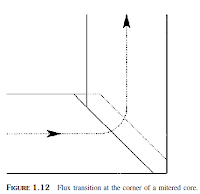TRANSFORMER CORE DESIGN AND CONSTRUCTION BASIC INFORMATION
Transformer Core Design and Construction: A Tutorial
Air gaps in a magnetic core will add considerable reluctance to the magnetic circuit. Remembering that the inductance of a coil and the magnetic reluctance are inversely proportional, air gaps reduce the inductance of the coil and increase the magnitude of magnetizing currents. In practical transformers, we want to reduce magnetizing currents to almost negligible levels; it is therefore important to eliminate all air gaps if possible.
One approach would be to make the core from a solid block of material. This is impractical from the standpoint of fabricating the transformer, since the coils would have to be wound through the core window.
Also, since metallic core materials conduct electric current as well as magnetic flux, the induced voltages would produce large circulating currents in a solid core. The circulating currents would oppose the changing flux and effectively ‘‘short out’’ the transformer.
A practical solution is to fabricate the core from thin laminated steel sheets that are stacked together and to coat the surfaces of the laminations with a thin film that electrically insulates the sheets from each other. Steel not only has excellent magnetic properties but is also relatively inexpensive and easy to fabricate into thin sheets.
In a modern transformer plant, steel ribbon is cut into sections by a cutting/punching machine commonly called a Georg machine. The sizes and shapes of the sections are determined by the core design of the individual transformer.
The thickness of the sheets varies somewhat; core laminations operating at 60 Hz are between 0.010 and 0.020 in. thick, with 0.012 in. being the most common thickness in use today.
Different methods of stacking core steel have been used in the past. One such method is called the butt lap method using rectangular core sections and is illustrated in Figure 1.11
Even if the edges of the segments do not butt together perfectly, as shown in the exaggerated edge view at the bottom of the figure, the alternating even and odd layers assure that the magnetic flux has a continuous path across the surfaces of the adjacent layers.
The type of construction depicted above works best with core steel that is not grain oriente, i.e., where permeability does not depend on the direction of the flux through the steel.
One of the greatest contributions to transformer efficiency and low cost was the introduction of grain-oriented steel in the 1940s. Grain-oriented steel is a silicon-iron alloy that is rolled or ‘‘worked’’ during fabrication in such a way that the permeability is higher and the hysteresis losses are lower when the flux is in the direction of the ‘‘grain.’’
Unfortunately, the properties of this steel for a flux that goes ‘‘against the grain’’ are much worse than the non-grain-oriented steel. Therefore, the design of the core has to take this into account. When using grain-oriented steel, the lamination sections are mitered at a 45° angle so that when the flux changes direction by 90°, it more or less still follows the grain of each of the segments.
Figure 1.12 depicts a corner overlap using core sections with 45° mitered edges. The grain of the steel is oriented along the length of the laminations in the horizontal and vertical directions. The flux is at a 45° angle to the grain at the mitered edges.
Alternate layers are cut into slightly different lengths and their corners have slightly different shapes. The modern multistep layer method uses up to five layers of differently shaped sections. This method is illustrated in Figure 1.13 with the first three layers exploded to show the stacking sequence.
The cross section of a transformer core can either be square or rectangular; however, a round shape is used in most large transformers of the so-called core form design, where the coils have a round cross section. With a round core within round coils, the use of space and materials is more efficient.
Attaining a round cross section with thin steel laminations is not that difficult, although this complicates the design. The design engineer is usually content with approximating a circular core, as shown schematically in.
Note that the actual laminations are too thin to show individually. The empty spaces between the core and the circular coil are filled with wooden dowels or other spacer materials to improve the mechanical strength of the transformer.



No comments:
Post a Comment